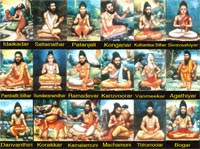So far we have seen the information concerning the attainment of saya purusha darshan from previous post.
In this regard, we may obtain enormous information from Bogar’s book, “Bogar 7000”. Moreover, he gave the preparatory information of an ink (mai) for easily achieving this darshan. On giving this information, he shared that this piece of information is once told to him by Siththar Kaalanginathar
பாரேதான் சரநூலாம் பஞ்சபட்சி
paaraethaan saranoolaam panchapatchi
பாரினிலே மாணாக்கன் பிழைக்கஎன்று
paarininlae maanakkan pizhaikkaenru
நேரேதான் சாத்திரத்தை பாடிவைத்தார்
naeraethaan saaththiraththai paadivaiththaar
நீதியுடன் சாயவின் தரிசனத்தை
neethiyudan saayavin tharisinaththai
சேரேதான் தரிசனத்தை காண்பதற்கு
saeraethaan tharisinaththai kaanpatharkku
செம்மலுடன் வழிசொன்னார் மைதான்இல்லை
semmaludan vazhisonnaar maithaanillai
கூரேதான் மையினது மார்க்கம்தன்னை
kooraethaan maiyinathu maarkkamthannai
கூறினேன் காலங்கி கடாட்சந்தானே
koorinaen kaalangi kadaatchanthaanae
தானான சித்துமுனி கும்பயோனி
thaanaana sithhtumuni kumbayoni
தாரணியில் கருவதனை மறைத்தும்போட்டார்
thaaraniyil karuvathanai maraiththumpoattaar
மானான காலங்கி எந்தன்நாதர்
maanaana kaalangi enthannaathar
மகாதேவர் கடாட்சமது கிருபையாலே
makaathaevar kaadatchamathu kirupaiyaalaee
தேனான கருக்குருவை யானும்கற்று
thaenaana karukkuruvai yaanumkatru
தெளிவாக மாணாக்கர் பிழைக்கஎன்று
thelivaaka maanakkar pizaikkaenru
பானான சாஸ்திரங்கள் யாவும்பார்த்து
paanaana saasthirangal yaavumpaarththu
பாருலகில் பாலர்க்குப் பாலித்தேனே
paarulakil paalarkkup paaliththaenae.
Bogar also told that, all Siththars teaches their students with various books like Saranool, Panchapatchi, Saaya darshan etc. however, they used to hide the information about this ink (mai) which is essential for getting saaya darshan easily. But, Bogar gave us this precious information by which we can easily infer the uniqueness and the significance of the information.
பாலிப்பேன் இன்னமொரு மார்க்கம்கேளும்
paalippaen innamoru maarkkamkaelum
பாங்கான புலிப்பாணி மைந்தாகேளு
paangaana Pulippaani mainthaakaelu
நீலியென்ற கருங்காலி மூலிதானும்
neeliyenra karungaali moolithaanum
நீட்சியுடன் கண்ணனுட மூலிவேரும்
neetchiyudan kannanuda moolivaerum
சூலியென்ற நத்தையின் சூரியப்பா
sooliyenra naththaiyin sooriyappaa
சூரியனார் காந்தியது மூலிவேரும்
sooriyanaar kaanthiyathu moolivaerum
வேலியென்ற பருத்தியப்பா இருவேலிதானும்
vaeliyenra paruthhtiappa iruvaelithaanum
வேகமுள்ள கருப்பு ஊமத்தைவேரே
vaekamulla karuppu oomaththai aerae
வேரான சடையனது மூலிதானும்
vaeraana sadaiyanathu moolithaanum
வேகமுடன் பொன்னின் ஊமத்தைவேரும்
vaekamudan ponnin uumaathivaerum
தூரான மையூரின் சிகையும்கூட்டி
thooraana maiyoorin sikaiyumkootti
துப்புரவாய்த் தான்சுருக்கிப் பொடியத்தாக்கி
thuppuravaaith thaansurukkip podiyathaakki
சேரான பொடிதனிலே ஐங்கோலத்தைச்
saeraana podithanilae aingoalaththaich
செப்பமுடன் தான்உரைத்துச் சொல்லக்கேளு
seppamudan thaanuraiththuch sollakkaelu
கூரான புழுகுரோசனை யும்சேர்த்து
kooraana puzhukuroasanai yumsaerththu
குறிப்புடனே மைசேர்த்து அரைத்திடாயே
kurippudanae maisaerththu araiththidaayae.
சேர்த்துமே பேரண்டந் தன்னில்அப்பா
saerththumae paerandan thannil appaa
செம்மலுடன் மையதனை பிடித்துக்கொண்டு
semmaludan maiyathanaip pidiththukkondu
கோர்த்துமே குமரியுடமையும் கூட்டி
koarththumae kumariyudamaiyum kootti
கொற்றவனே தான் அரைத்துச் சிமிளில்வைத்து
kotravanae thanaraiththich simililvaiththu
பார்த்துமே நேத்திரமாம் புருவந்தன்னில்
paarththumae naethhtiramaam puruvanthannil
பாலகனே மைதீட்டி ஆகாயத்தை
paalakanae maitheetti aakaayaththai
தீர்த்துமே பார்க்கின்ற காலந்தன்னில்
theerththumae paarkkinra kaalanthannil
திறமுடனே தரிசனம் தெரியும்தானே
thiramudanae tharisanam theriyumthaanae.
தானான சூரியனை மேகம்தானும்
thaanaana sooriyanai maekamthaanum
சட்டமுடன் மேகமது மறைந்திட்டாலும்
sattamudan maekamathu marainthittaalum
பானான மேகமதுக் குள்ளிருக்கும்
paanaana maekamathuk kullirukkum
பாலகனே சூரியனும் கண்ணில்தோன்றும்
paalakanae sooriyanum kannilthonrum
மானான சந்திரனைக் காணும்போது
maanaana chanthiranaik kaanumpaothu
மகத்தான தரிசனையும் கண்ணில்தோற்றும்
makaththaana tharisanaiyum kannilthoatrum
தேனானதே சொளிவின் மயத்தைபோல
thaenaanathae solivin mayaththippoala
ஜெகசோதி மின்னல்போல் தோற்றும்பாரே
jekasoathi minnalpoala thooatrumpaarae.
பாரேதான் மையினால் மேகசாலம்
paaraethaan maiyinaal maekasaalam
பாங்குடனே கரிசனையும் காணலாகும்
paangudanae karisanaiyum kaanalaakum
நேரேதான் இக்கருவை சித்தர்தானும்
naeraethaan ikkaruvai siththarthaanum
நெறிமுறைமை தான்அறிந்து கூறாமல்தான்
nerimuraimai thaanarinthu kooraamalthaan
சீரேதான் கருக்குருவை மறைத்துவிட்டு
seeraethaan karukkuruvai maraiththuvittu
சீர்தப்பித் தெரிசனத்தைப் பாடிவைத்தார்
seerthappith therisanaththai paadivaiththaar
ஆரோதான் எனைப்போல் சொன்னாராப்பா
aaroathaan enaippoal sonnaaraappaa
அப்பனே உண்மையது உரைத்திட்டோமே
appanae unmaiyathu uraiththittomae.
Take the equal amount of following ingredients: karungaali, kannai mooli root, naththai soori, root of sunflower, vaelipparuththi, karu oomaththai root, ponnoomaththai root and maiyoor sikai and then cut it all into small pieces like powder.
Now grind this powder with aingoalak karu and add equal amount of punuku and koarosoanai with this grinded mixture and grind it all well. Now put the above paste along with aerandath thailam and kumara mai in kalvam and grind once again and collect it in container.
Now, one can use this mai as thilakam which is usually worn between eyebrows during the period of attaining saaya darshan. Now, one should focus their vision on own shadow and after look into clear blue sky, where we can easily get the saaya purusha darshan.
Translated by Lalithambika Rajasekaran

